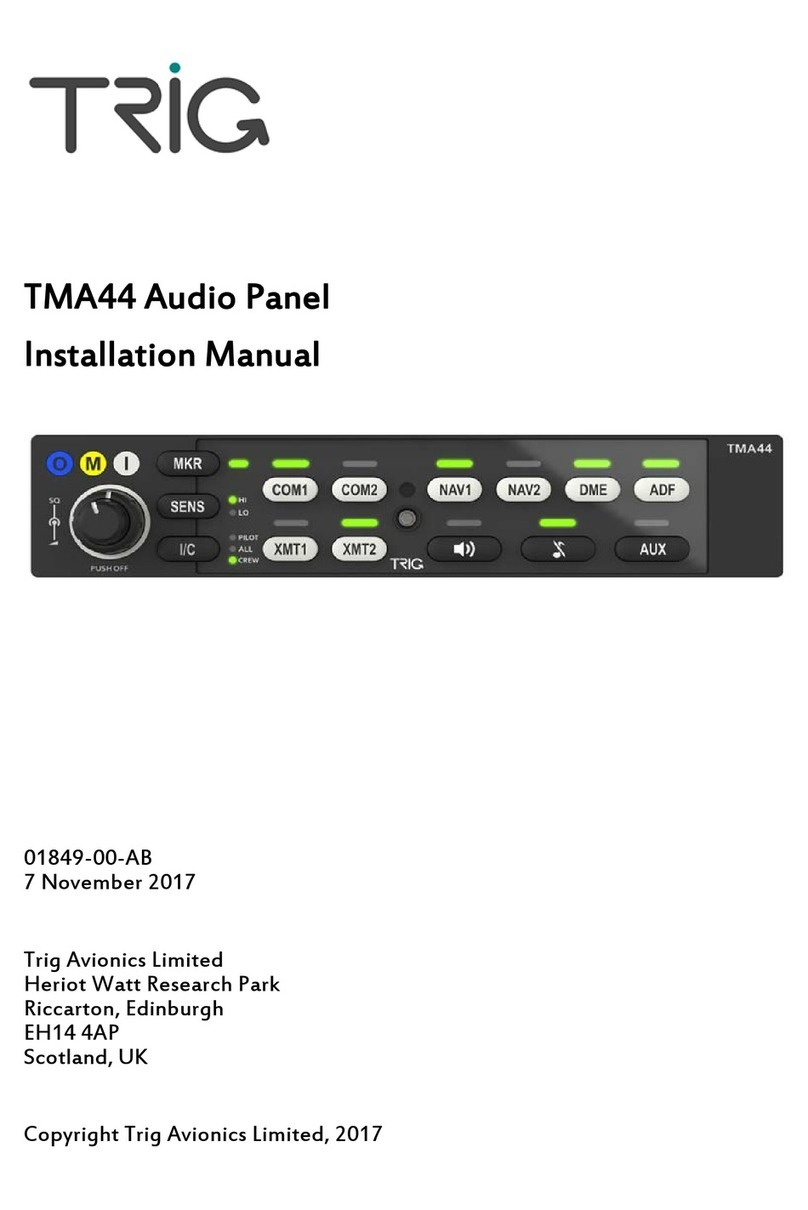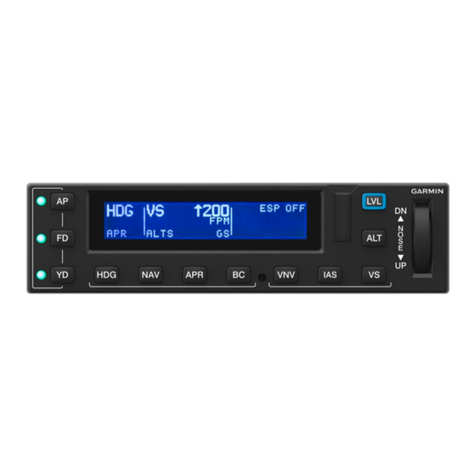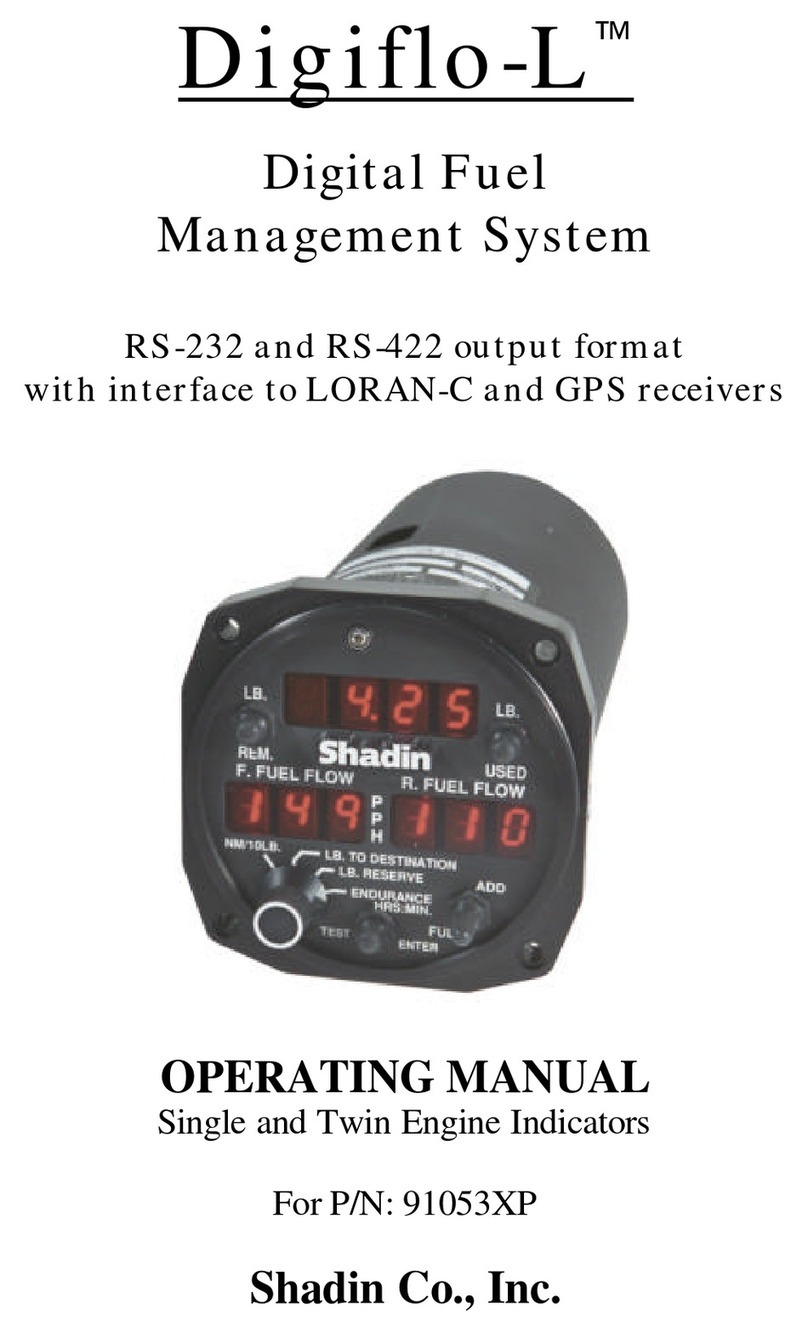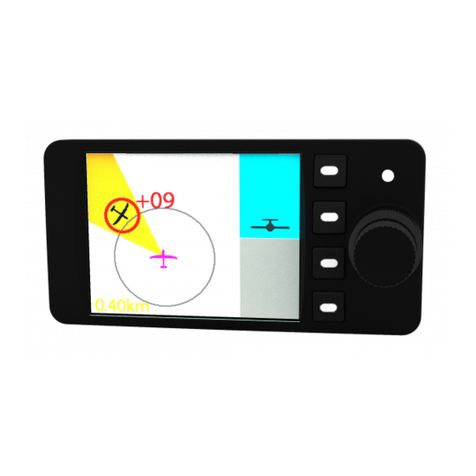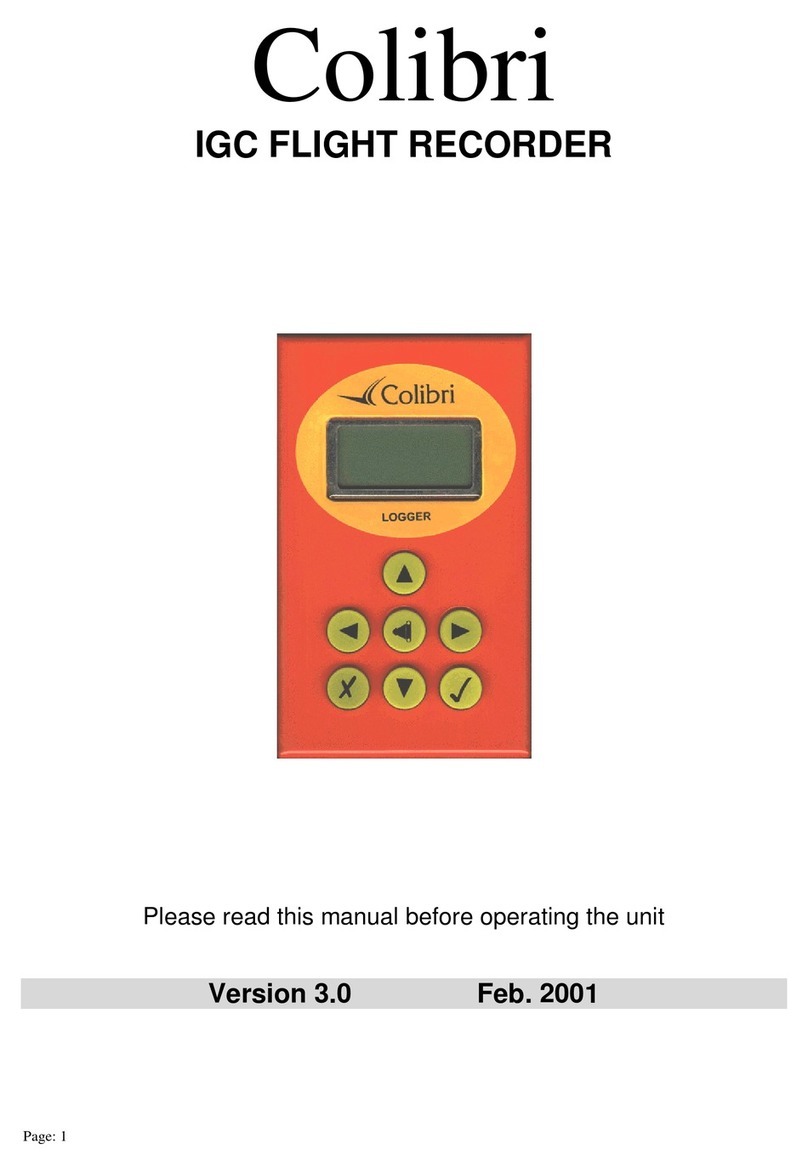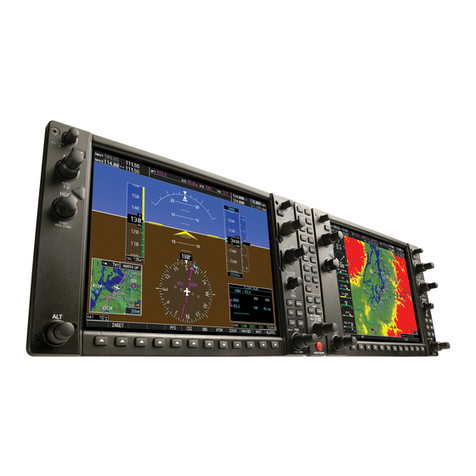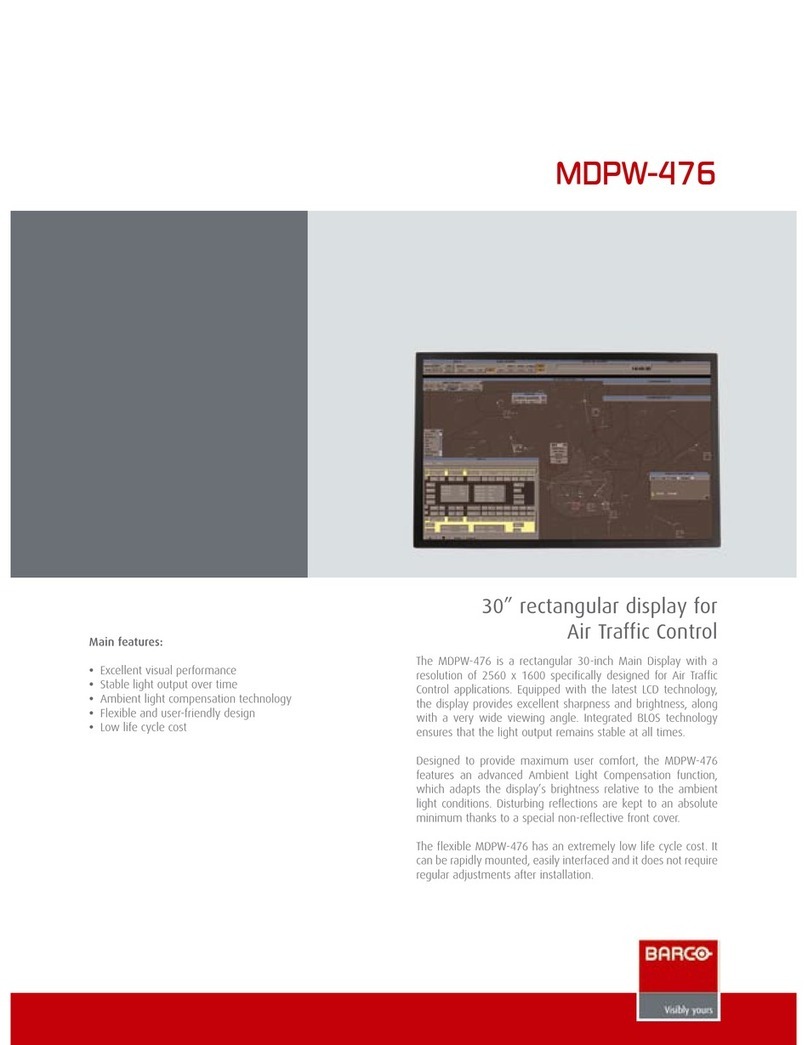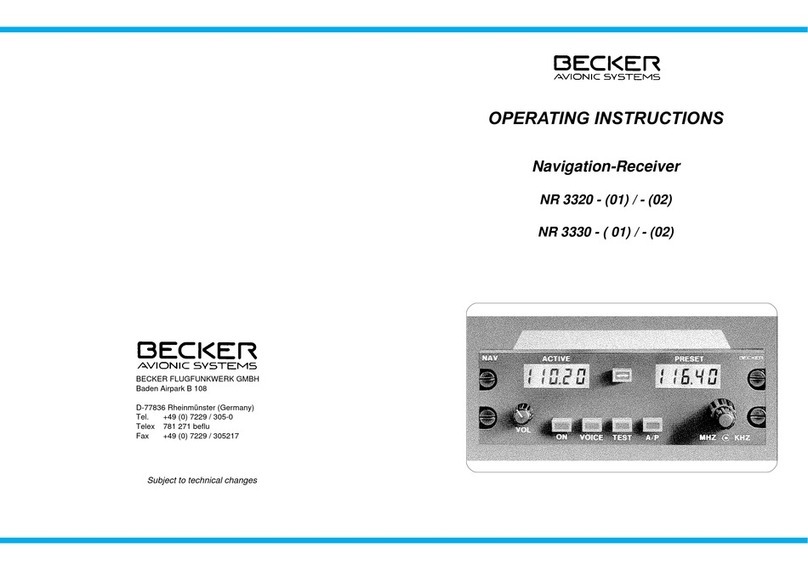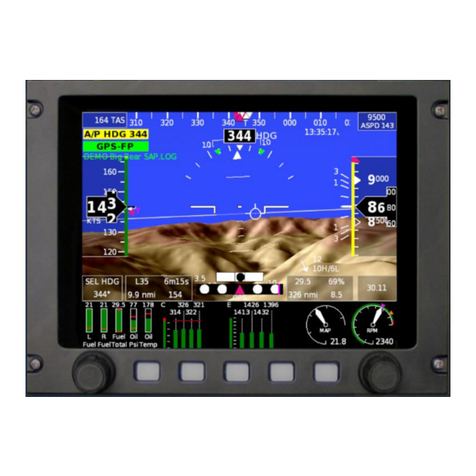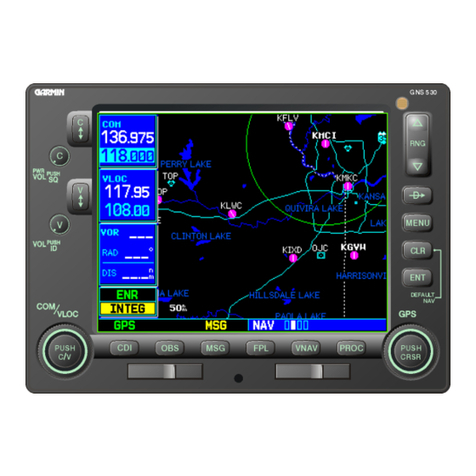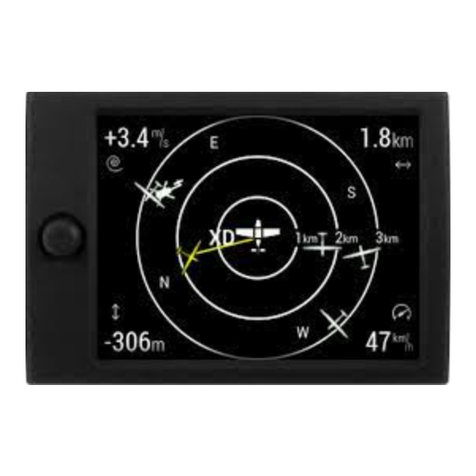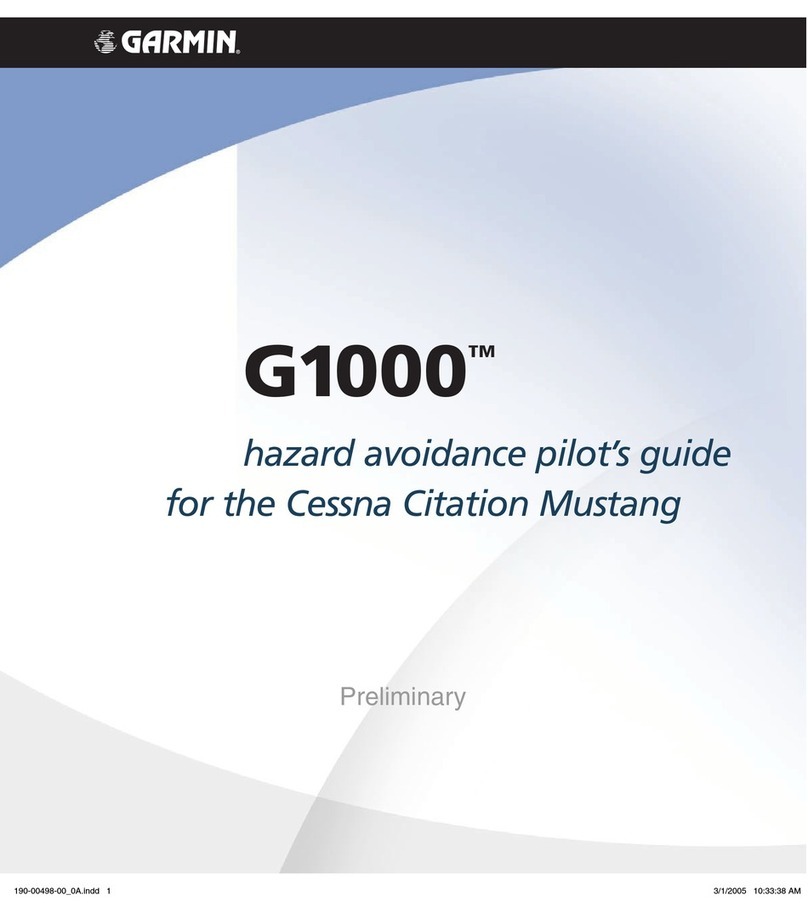trig TMA45 User manual

TMA45 Audio Panel
Operating Manual
01851-00-AA
27 Mar 2018
Trig Avionics Limited
Heriot Watt Research Park
Riccarton, Edinburgh
EH14 4AP
Scotland, UK
© Copyright 2018
EN / DE / FR


EN
1
Front Panel
Power On and Fail-Safe Operation
The audio panel is turned on and off by pressing the volume control knob
(smaller, inner knob on left side of unit).
When the system is turned off or if power is removed the audio panel will be
placed in the fail-safe mode. In the off or fail-safe mode, the pilot is
connected directly to Com 1 and to unswitched input 1, allowing transmit,
receive and alert capability regardless of audio panel condition.
The fail-safe audio will only be heard in the left ear of a stereo headset.
Transmitter Selection
To select a radio for transmission, press either the XMT1 or the XMT2 button;
the green indicator lamp above the button will light up, indicating which radio
you will transmit on. The corresponding COM1 or COM2 indicator will also
light up; you always hear the audio from the transceiver that is selected for
transmit.
Both pilots can transmit on the selected radio, but only the person who presses
their Push-To-Talk switch will be heard over the aircraft radio.
Receiver Selection
To listen to both radios press the COM1 or COM2 button as required to
enable the second radio. Both radios will remain selected until one is
manually deselected.
Navigation Audio Selection
The MKR, NAV1, NAV2, DME and ADF buttons select the switched navigation
receivers. Press once to turn on the corresponding source, press again to turn

EN
2
it off; a green lamp above the button will light indicating which audio source is
selected.
The DME input, if present, is shared with AUX.
Cockpit Speaker
This button will place all selected audio on the cockpit speaker when active.
Note: In Split mode (see below), the speaker carries the same audio
as the pilot.
To help reduce power consumption and internal heat build-up in the avionics
stack, switch off the speaker when not in use.
Swap Mode
The optional Swap button, usually mounted on the control yoke, switches
between the Com transmitters without having to reach for the audio panel.
Pressing the Swap button has exactly the same effect as switching between
XMT1 and XMT2 on the audio panel.
Split Mode
Pressing both XMT1 and XMT2 buttons at the same time puts the TMA45 into
Split mode; all four COM and XMT indicators will light up. This connects the
pilot to Com 1 and the co-pilot to Com 2, and they can use their respective
radios independently. The passengers will not hear the radios or crew
intercom in Split mode.
Press either XMT button to exit Split mode.
It is not possible to place the pilot on Com 2 and the co-pilot on Com 1.
In Split mode, only the pilot will hear the selected navigation audio.
An example of this feature is when the pilot may want to talk to Air Traffic
Control, while the co-pilot may be speaking to ground handling agents.
Note: Due to the nature of VHF communications signals, and the
size constraints in general aviation aircraft, it is probable that there
will be some transmission bleedover in Split Mode, particularly on
adjacent frequencies. Split Mode may not be suitable in all aircraft
conditions.
Intercom Volume
Turning the smaller volume control knob on the left side of the audio panel
adjusts the loudness of the intercom for the pilot and co-pilot. It has no effect
on selected radio levels, music input levels or passengers' volume level.
Turning the larger, outer volume control knob on the left side of the audio
panel adjusts the intercom volume for the passengers. It has no effect on radio
or music levels.

EN
3
Trig Digital Noise Reduction
The TMA45 provides an automatic VOX squelch control (TDNR). Each
microphone input is monitored through a digital processor and opens instantly
when human speech is detected. This results in seamless conversations aboard
the airplane for crew and passengers, without syllable clipping or fatigue-
inducing noise.
No manual control or field adjustment is required.
The system is designed to block continuous tones, therefore people humming
or whistling in monotone may be blocked after a few moments.
For consistent performance, any headset microphone must be placed within
¼-inch of the lips, preferably against them. It is important to have the
microphone element parallel to the mouth, and not twisted inside the cover.
You should also keep the microphone out of a direct wind; moving your head
through an air stream may cause the TDNR to open momentarily.
The TDNR is designed to work with normal aircraft cabin noise levels (70 dB
and above), therefore it may not always recognize speech and clip syllables in
a quiet area, such as in the hangar, or when the engine is not running.
Intercom Modes
The Intercom (I/C) button is a 3-function mode selector that allows the pilot
to tailor the intercom function to best meet the situation; it cycles through the
following intercom modes, from top to bottom.
PILOT: The pilot is isolated from the intercom and is connected only
to the aircraft radios. Co-pilot and passengers will hear the intercom
and Music 1, but not the aircraft radio receptions or pilot
transmissions.
ALL: All parties will hear the aircraft radios, intercom and Music 1.
CREW: Pilot and co-pilot are connected on one intercom channel
and have exclusive access to the aircraft radios. They may also listen
to Music 1. Passengers can continue to communicate amongst
themselves without interrupting the crew and may listen to Music 2.
When in Split mode, the ALL intercom mode is not available and pressing the
Intercom button will cycle between PILOT and CREW modes.

EN
4
Intercom Mode Table
Mode Pilot Hears Co-pilot Hears Passengers
Hear
Comments
Pilot Radios
Sidetone
Passengers
Music 1
Co-pilot
Passengers
Music 1
This mode allows the pilot to
communicate with air traffic
control without the co-pilot or
passengers hearing the
conversation. Co-pilot and
passengers can continue to talk
and listen to music.
All Radios
Sidetone
Co-pilot
Passengers
Music 1
Radios
Sidetone
Pilot
Passengers
Music 1
Radios
Sidetone
Pilot
Co-pilot
Passengers
Music 1
This mode allows all on board
to hear radio reception as well
as communicate on the
intercom.
Crew Radios
Sidetone
Co-pilot
Music 1
Radios
Sidetone
Pilot
Music 1
Passengers
Music 2
A second music source is
automatically enabled for the
passengers.
Trig Active Mute
Trig Active Mute, when enabled, will automatically decrease the music volume
during any voice communication and gradually restore it to its original level
after communications are complete.
Music source 1 (Music 1 input, front panel jack or Bluetooth streaming) has
three muting modes, which are cycled through by pressing the Mute button
and announced in the headset as they are activated.
Radio Mute: aircraft radio activity mutes the music
Mute on: radio and intercom mute the music
Mute off: nothing interrupts the music
Music 2 has muting on or off, and can be controlled only if your installation
includes an external switch.

EN
5
Monitor Mode
Press and hold COM2 for more than two seconds to activate and deactivate
Monitor mode; an audio annunciation will report changes to the Monitor
mode status.
In Monitor mode, the audio from the radio selected for transmit will mute the
other Com radio.
For example, if Com 1 is selected to transmit to Air Traffic Control and Com 2
is receiving weather information, the audio from the weather will be muted
while Air Traffic Control is transmitting.
When Monitor mode is on, the indicator lamp of the radio selected for receive
only will blink every three seconds.
Monitor mode is not available in Split mode and is defaulted to off when the
audio panel is turned on.
Telephone Mode
The Telephone mode serves as a full duplex interface and distribution for
telephone systems such as mobile phones with earpiece jacks or Bluetooth
connectivity.
Pressing the Telephone button connects the telephone to the users as follows:
In PILOT intercom mode, only the pilot will hear the telephone, and
only they will be heard. No telephone sidetone can be created in
PILOT Mode; selecting PILOT mode during a call will cause the
sidetone, if present, to disappear.
In ALL intercom mode, all crew and passengers will hear and be heard
on the phone when they speak.
In CREW intercom mode, only the pilot and co-pilot are connected
to the telephone, passengers will not hear or be heard on the call.
Com and other selected radio audio is also heard in the headsets as specified
by the Intercom mode. The radio PTT will switch the microphone output to the
selected radio and allow continued aircraft communication. The telephone
party will not hear Com radio communications, and vice versa.
A phone call can only be initiated from the phone itself.
In cases where the mobile phone doesn’t provide sidetone, the audio panel
can be configured, by holding the TEL button for more than one second, to
create sidetone for you.
Trig recommends the use of mobile devices in a way that maintains safe flight
operations and good airmanship at all times.
Bluetooth®
A Bluetooth-enabled mobile phone must first be paired with the TMA45
before it can be used wirelessly for making calls or streaming music.

EN
6
Activate the “seek device” function on the mobile phone, and then enter the
access code “0000” (if required) when the phone detects the TMA45 on the
list of available devices. This process must be repeated for any phone to be
used, and only one mobile phone can be paired with the TMA45 at any one
time.
A second Bluetooth-enabled device can be used to stream music, but it must
be paired and connected after the mobile phone.
If a paired device fails to reconnect, the Bluetooth interface can be reset by
holding both the DME and ADF buttons while the TMA45 is powered on; a
“Bluetooth reset” annunciation will be heard in the headphones. The device
must then be paired again.
Utility Jack
The 2.5 millimetre (3/32”) jack on the front of the TMA45 has three distinct
functions: mobile phone interface, music input and priority advisory audio
input.
A mobile phone can be connected to the TMA45 via the front panel
jack using a phone-specific adapter cord; the mobile phone is added
to the intercom loop by pressing the Telephone button. Regardless
of the Telephone mode setting, the telephone ringer audio will be
heard in the intercom if it is present on the telephone’s output
(ringer may be muted by radio and intercom).
The utility jack can be used as stereo music input by using an
appropriate adaptor cord and will be treated as Music 1. Please note
that the adapter cord needed for music input is different from the
one for mobile phone input.
When an audio signal is actively playing on Music 1 through the rear
connector or via Bluetooth, the front jack automatically becomes a
priority advisory input that is not muted by radio or intercom. It will
be heard by all parties regardless of the Intercom mode and may be
used for auxiliary systems such as a GPS terrain advisory or portable
traffic watch system.
Marker Beacon Receiver
The marker beacon receiver uses visual and audio indicators to alert you when
the aircraft passes over a 75 MHz beacon transmitter.
The marker beacon audio can be enabled and disabled by pressing the MKR
button. A green lamp to the right of the button will light when the audio is
enabled.

EN
7
The blue outer marker lamp has an associated 400 hertz 'dash' tone.
The lamp and tone are keyed at a rate of two per second when the
aircraft is in the range of the outer marker.
The amber middle marker lamp is coupled with a 1300 hertz tone,
keyed alternately with short 'dot' and long 'dash' bursts at 95
combinations per minute.
The white inner marker lamp has a 3000 hertz 'dot' tone. The lamp
and tone are keyed at a rate of six times per second.
The sensitivity (SENS) button can be used to change the marker beacon
receiver sensitivity to high or low. Use HI sensitivity only when navigating
using fan markers on airways. For normal ILS marker beacons the sensitivity
should always be set to LO.
Holding the SENS button for one second illuminates all three lamps
simultaneously to assure the lamps (internal and external) are in working
order. It will also cause the marker audio to mute for that beacon; the next
beacon received will reactivate the audio. Releasing the SENS button restores
the last sensitivity.

DE
8
Bedienelemente
Power und Fail-Safe Modus
Der Strom des Gerätes wird durch Drücken des Lautstärkereglers ein- und
ausgeschaltet (der kleinere, innere Knopf an der linken Seite der Anlage).
Wenn der S`trom ausgefallen ist oder sich ausgeschaltet hat, wechselt die
Aufschaltanlage in Fail-Safe Modus.
In diesem Modus ist der Pilot direkt an Com 1 und ungeschalteten Input #1
angeschlossen, welches der Aufschaltanlage ermöglicht - gleich in welchem
Zustand - senden und empfangen zu können.
Das ausfallsichere Audio wird nur im linken Ohr von Stereo-Kopfhörern
gehört.
Senderauswahl
Drücken Sie entweder XMT1 oder XMT2, um ein Funkgerät auszuwählen. Das
grüne Anzeigelämpchen oberhalb der Taste wird aufleuchten, welches Ihnen
anzeigt, auf welchem Funk Sie senden. Das entsprechende Anzeigelämpchen
wird auch aufleuchten – man hört immer das Audio vom Empfänger, der
früher ausgewählt wurde.
Beide Piloten können über das ausgewählte Funkgerät übertragen, aber nur
die Person, die den Push-to-Talk Schalter aktiviert, wird im Flugfunk gehört.
Empfängerauswahl
Beide Funkgeräte können gleichzeitig gehört sein. Drücken Sie entweder Com
1 oder Com 2 nach Bedarf, um das zweite Funk zu aktivieren. Beide Geräte
werden solange gehört bis eins manuell deaktiviert wird.

DE
9
Navigationsaudio Auswahl
Die Tasten MKR, NAV1, NAV2, DME und ADF wählen die geschalteten
Navigationsempfänger aus. Drücken Sie einmal, um die entsprechende Quelle
einzuschalten und dann noch einmal, um sie auszuschalten. Ein grünes
Anzeigelämpchen oberhalb der Taste wird aufleuchten und anzeigen, welche
Audioquelle ausgewählt ist.
Die DME-Eingabe, falls da, ist mit AUX geteilt.
Cockpit Speaker
Wenn aktiv, setzt diese Taste alle geschaltete Audio in den Cockpit Speaker
ein.
Anmerkung: Im Split-Modus (siehe unten) werden nur
ungeschalteten Audioeingäbe über den Lautsprecher abspielen.
Um den Energieverbrauch und Wärmestau in der Instrumententafel zu
verringern, schalten Sie den Lautsprecher aus, wenn unbenutzt.
Swap Modus
Die optionale Taste „Swap“ (normalerweise am Steuerhorn montiert) wechselt
zwischen den COM Transmittern, ohne nach dem Audio Panel greifen zu
müssen. Drücken der Taste „Swap“ hat dieselbe Wirkung wie der Wechsel
zwischen XMT1 und XMT2 auf dem Audio Panel.
Split Modus
Split Modus ist durch gleichzeitiges Drücken von beiden XMT1 und XMT2
Tasten erreicht – alle vier COM und XMT Anzeigelämpchen werden
aufleuchten.
Dies verbindet den Piloten mit Com 1 und den Copiloten mit Com 2 – das
heißt sie können ihre eigenen Funk selbständig verwenden. Passagiere hören
nichts, wenn der Split Modus aktiv ist.
Drücken Sie XMT, um den Split Modus abzuschalten. In diesem Modus ist es
dem Piloten unmöglich, über Com 2 zu übertragen und das Gleiche gilt für
den Copiloten über Com 1. Im Split Modus kann nur der Pilot das ausgewählte
Navigationsaudio hören. Dies könnte wohl vorteilhalt sein, falls der Pilot mit
Flugsicherung sprechen will, während der Copilot mit
Bodenabfertigungsagenten kommuniziert.
Anmerkung: aufgrund der Art der Ultrakurzwellesignale und
Platzerschränkungen in einem allgemeinen Flugzeug, wird es wohl
etwas Übertragungsüberlauf geben im Split Modus, besonders über
Nachbarfrequenzen. Es garantiert sich nicht, dass der Split Modus für
alle Flugbedingungen gilt.

DE
10
Lautstärkeregler des Intercoms
Drehen des Lautstärkereglerknopfes (des kleineren, inneren Knopfes an der
linken Seite des Gerätes) stellt die Lautstärke des Intercoms in allen
Kopfhörern für den Piloten und Copiloten ein. Das hat keine Auswirkung
weder auf ausgewählten Hörfunk noch auf die Lautstärke der Musik.
Drehen des größeren, äußeren Lautstärkereglers auf der linken Seite des
Gerätes justiert die Intercomlautstärke der Passagiere. Das hat keinen Einfluss
auf die Lautstärke der Radios oder der Musik.
Trig Digital Noise Reduction
Die TMA45 enthält eine automatische VOX Squelch Steuerung. Jeder
Mikrofoneingang wird durch einen Digital-Prozessor überwacht und öffnet
sich sofort, wenn menschliche Sprache erkannt wird. Dies bietet für Crew und
Passagiere eine reibungslose Kommunikation an Bord des Flugzeugs, ohne ein
Verschlucken von Silben, oder ermüdenden Lärmpegel ertragen zu müssen.
Kein manuelles Steuern oder Justieren ist notwendig.
Das System ist so angelegt, Dauertöne zu blockieren, deshalb können Brumm-
oder Pfeifgeräusche nach kurzer Zeit blockiert werden.
Für eine gleichbleibend gute Verständigung darf jedes Headset Mikrofon
nicht weiter als 6 mm von den Lippen entfernt sein. Dabei ist es wichtig, das
Mikrofon parallel zum Mund und nicht verdreht angeordnet zu haben.
Das Mikrofon sollte nicht direktem Luftzug ausgesetzt sein; bei einer
Kopfbewegung durch einen Luftstrom könnte die TDNR Funktion einsetzen.
Die TDNR Funktion ist so angelegt, mit normalen Kabinengeräuschpegeln (ab
70 dB) zu arbeiten. Es ist deshalb möglich, dass in einer ruhigen Umgebung,
wie in einem Hangar oder bei nichtlaufendem Motor, Sprache vielleicht nicht
erkannt wird und Silben verschluckt werden.
Modi des Intercoms
Die Taste I/C ist ein Betriebsartenselektor mit 3 Funktionen, der dem Piloten
erlaubt, die Funktion des Intercoms maßzuschneidern. Die drei Fuktionen
sind:
PILOT: der Pilot ist vom Intercom isoliert und nur an die Funkgeräte
des Flugzeuges angeschlossen. Der Copilot und die Passagiere hören
das Intercom und Musik jedoch nicht die Funkempfänger des
Flugzeuges oder Sendungen des Piloten.
ALL: alle können die Funkgeräte hören, ebenso Intercom wie auch
Music 1.
CREW: der Pilot und Copilot sind an einen Intercom Kanal
angeschlossen und haben ausschließlichen Zugriff auf die
Funkgeräte. Sie können auch Music 1 hören. Die Passagiere können

DE
11
weiterhin miteinander sprechen und Music 2 hören, ohne die
Besatzung zu stören.
Im Split Modus ist die „ALL“ Intercom Betriebsart nicht möglich und durch
Drücken der Intercom Taste wird ein Wechsel zwischen PILOT und CREW
Funktion ermöglicht.
Intercom Mode Tabelle
Modus Pilot hört Copilot hört Passagiere
hören
Kommentare
Pilot Funkgeräte
Mithörton
Passagiere
Music 1
Copilot
Passagiere
Music 1
Dieser Modus ermöglicht dem
Piloten mit ATC zu
kommunizieren. Der Copilot
und die Passagiere können
weiter miteinander sprechen
und Musik hören..
Alle Funkgeräte
Mithörton
Copilot
Passagiere
Music 1
Funkgeräte
Mithörton
Pilot
Passagiere
Music 1
Funkgeräte
Mithörton
Pilot
Copilot
Passagiere
Music 1
Dieser Modus ermöglicht allen
an Bord des Flugzeugs sowohl
Funkempfang zu hören, als
auch über das Intercom
miteinander zu
kommunizieren.
Crew Funkgeräte
Mithörton
Copilot
Music 1
Funkgeräte
Mithörton
Pilot
Music 1
Passagiere
Music 2
Eine zweite Musikquelle wird
automatisch für die Passagiere
aktiviert.
Trig Active Mute
Wenn dieser Modus aktiv ist, verringert sich die Musiklautstärke automatisch
bei Anliegen einer Sprechverbindung, um nach Beendigung der
Sprechverbindung allmählich wieder die ursprüngliche Lautstärke
einzunehmen.
Die Musikquelle #1 (Music 1 Eingang, Klinkenbuchse oder Bluetooth) hat drei
Muting Betriebsarten. Diese können durch Drücken der Mute Taste
sequenziell aktiviert werden und sind im Headset zu hören.
Radio Mute: Funkempfang schaltet die Musik stumm
Mute on: Funkempfang und Intercom schalten die Musik stumm
Mute off: Musik bleibt an
Music 2 hat Mute on und Mute off und kann von außen gesteuert werden.
Monitor Modus
Die Monitor Betriebsart kann durch Halten der COM2 Taste länger als 2
Sekunden, aktiviert werden. Im Monitor Betrieb hört man nur das Com, mit
dem gesprochen wird während das andere Com stummgeschaltet bleibt.

DE
12
Das heißt; falls zum Beispiel auf Com 1 mit ATC gesprochen wird, während
Com 2 Wetterinformationen empfängt – wird diese Information während der
ATC Sendung stummgeschaltet.
Ein eingehender Empfang zeigt Änderungen der Monitor Betriebsart an.
Wenn das Modus „Monitor“ ausgewählt worden ist, wird das
Anzeigelämpchen des zum Empfangen ausgewählten Funkgerätes alle drei
Sekunden blinken.
Im Split Modus ist die Monitor Betriebsart nicht möglich und wird bei
Einschalten des Gerätes automatisch ausgeschaltet
Telephone Modus
Der Telefon Modus bietet eine volle „duplex“ Möglichkeit für Telefonsysteme,
wie Handys mit Kopfhöreranschluss oder Bluetooth Einrichtung.
Durch Drücken der Telefontaste wird das Telefon wie folgt verbunden:
In der PILOT Intercom Betriebsart hört und spricht nur der Pilot über
das Telefon. Kein Mithörton kann sich im Pilot Modus erstellen
lassen.
In der ALL Intercom Betriebsart werden alle Crew Mitglieder und
Passagiere am Telefon gehört.
In der CREW Betriebsart werden nur der Pilot und Copilot mit dem
Telefon verbunden – die Passagiere hören den Anruf nicht.
COM und andere ausgewählte Empfänger sind auch gemäß der spezifischen
Intercom Betriebsart in den Kopfhörern zu hören. Die Sprechtaste schaltet das
Mikrofon auf den gewählten Sender, während der Funkverkehr nicht
unterbrochen wird.
Ein Telefonanruf kann nur vom Telefon selbst erfolgen.
Falls ein Handy keinen Mithörton hat, kann die Aufschaltanlage durch Halten
(länger als eine Sekunde) der TEL Taste so konfiguriert werden, dass es einen
Mithörton für Sie erzeugt.
Trig Avionics empfiehlt die Verwendung von Mobiltelefonen, nur wenn kein
Risiko für die Flugsicherheit besteht.
Bluetooth®
Damit ein Bluetooth-fähiges Handy drahtlos für abgehende Anrufe oder zum
Streamen von Musik benutzt werden kann, muss es zunächst mit der TMA45
gekoppelt werden.
Aktivieren Sie die Suchfunktion auf dem Mobiltelefon und geben Sie dann
den Zugangscode „0000“ ein (falls erforderlich), sobald das Handy das
„TMA45“ auf der „Liste der verfügbaren Geräte“ erkennt. Für jedes weitere
Mobiltelefon muss dieser Vorgang wiederholt werden;

DE
13
es kann jedoch nur ein Handy zur gleichen Zeit mit der TMA45 gekoppelt
werden.
Ein zweites Bluetooth-fähiges Gerät kann zum Streamen von Musik benutzt
werden, es muss jedoch im Anschluss an das erste Mobiltelefon gekoppelt und
angeschlossen werden.
Beim Einschalten kann durch gleichzeitiges Drücken beider Tasten „DME“ und
„ADF“ die Bluetooth-Schnittstelle zurückgesetzt werden. Eine Ansage
„Bluetooth reset“ ist in den Kopfhörern zu hören.
Multifunktionale Buchse
Die Buchse (2.5mm) auf der Vorderseite der TMA45 hat drei definierte
Funktionen: Handy Eingang, Priority Advisory Audio Eingang und
Musikseingang.
Durch Verwendung eines Handy-spezifischen Anschlußkabels kann
ein Handy an die TMA45 über die Buchse auf der Frontplatte
angeschlossen werden. Demzufolge wird das Handy durch Drücken
der "Telefon" Taste zum Intercom Loop hinzugefügt. Das Audio des
Klingeltons wird über das Intercom gehört sein, wenn er in der
Ausgabe des Telefons anwesend ist, unabhängig von den
verwendeten Moduseinstellungen (Klingeltöne können über Radio
oder Intercom stummgeschaltet sein).
Die Buchse kann durch Verwendung eines angemessenen
Anschlußkabels als Eingang für Stereo Musik verwendet werden und
wird dadurch als Music 1 behandelt. Bitte beachten Sie, dass
verschiedene Kabel für den Musikseingang und den Handy Eingang
erforderlich sind.
Wann ein Audiosignal aktiv auf Music 1 über den rückseitigen
Steckverbinder oder Bluetooth anliegt, wird die vordere Buchse
automatisch ein Priority Advisory Eingang, der weder vom Funk noch
Intercom stummgeschaltet wird. Das Signal wird von allen
Anwesenden gehört, unabhängig vom Intercom Modus und mag für
zusätzliche Hilfssysteme verwendet sein, wie zum Beispiel GPS
Terrain oder andere tragbare Luftverkehrsüberwachungssysteme.
Marker Beacon Empfänger
Der Marker Beacon Empfänger benutzt visuelle und akustische Signale, um Sie
zu alarmieren, wann ein Flugzeug über einen 75MHz Bakensender fliegt.

DE
14
Das Audio des Funkfeuers kann durch Drücken der Taste „MKR“ aktiviert und
deaktiviert werden. Ein grünes Anzeigelämpchen an der rechten Seite der
Taste wird aufleuchten, wenn das Audio aktiviert wird.
Die blaue, äußere Leuchte hat einen „dash“ Ton von 400 Hertz. Die
Leuchte und Ton sind zu einem Satz von zwei pro Sekunde getastet,
wenn das Flugzeug im Bereich des äußeren Funkfeuers fliegt.
Die gelbe, mittlere Leuchte hat einen Ton von 1,300 Hertz, die mit
kleinen „dot“ und langen „dash“ Schüben zu einem Satz von 95
Kombinationen pro Minute getastet ist.
Die weiße, innere Leuchte hat einen „dot“ Ton von 3,000 Hertz. Die
Leuchte und Ton sind zu einem Satz von sechsmal pro Sekunde
getastet.
Die „SENS“ Taste (Empfindlichkeit) kann benutzt werden, um die
Empfindlichkeit des Markierungsfunkfeuers von hoch auf gering zu setzen.
Benutzen Sie „HI“ Empfindlichkeit, nur wenn Sie Marker beim Navigieren auf
Flugstrecken benutzen. Die Empfindlichkeit sollte immer auf „LO“ für normale
ILS Marker eingestellt werden.
Halten der „SENS“ Taste für eine Sekunde gedrückt beleuchtet alle drei
Leuchten gleichzeitig, um sicherzustellen, dass sie alle funktionsfähig sind.
Dabei wird sich das Audio für das Funkfeuer stummschalten, aber wird schon
wieder aktiviert, wenn das nächste Funkfeuer empfangen ist. Loslassen der
„SENS“ Taste stellt die letzte Empfindlichkeitseinstellung wieder her.

FR
15
Panneau de contrôle
Marche, Arrêt, Sécurité
Appuyer sur le bouton rotatif (petit bouton sur la gauche du panneau) permet
la mise en marche ou l’arrêt du panneau de contrôle audio.
Lorsque le panneau audio est éteint ou en cas de panne d’alimentation, le
TMA45 passe en mode sécurité.
A l’arrêt ou en mode sécurité, le pilote est connecté directement à Com 1 et à
l’entrée #1 qui permet de transmettre, recevoir et d’avoir les alertes quel que
soit l’état du panneau de contrôle audio.
En mode sécurité, le son ne sera audible que du côté gauche du casque stéréo.
Sélection du transmetteur
Pour sélectionner une radio pour transmettre, appuyer sur le bouton XMT1 ou
XMT2, le voyant vert au-dessus du bouton XMT s’allumera indiquant la radio
active.
Le voyant vert COM1 ou COM2 correspondant s’allumera aussi.
Les deux pilotes peuvent transmettre sur la radio sélectionnée mais seul
l’utilisateur appuyant sur le bouton Push-To-Talk sera entendu sur la radio de
l’avion.
Sélection du récepteur
Pour écouter les deux radios, appuyer sur le bouton COM1 ou COM2 (bouton
de la radio inactive) pour activer la deuxième radio. Les deux radios resteront
actives jusqu’à ce que l’une soit manuellement désélectionnée.
Sélection Audio Navigation
Les boutons MKR, NAV1, NAV2, DME et ADF sélectionnent le récepteur actif.
Appuyer une fois pour activer le récepteur, appuyer à nouveau pour l’éteindre.

FR
16
Le voyant s’allumera au-dessus du bouton indiquant la source audio active.
L’entrée DME, si présente, est partagé avec AUX.
Bouton Cockpit Speaker
Ce bouton permet d’entendre l’audio sélectionné sur les hauts parleurs du
cockpit.
À noter: en mode SPLIT (voir ci-dessous), seules les fonctions non
sélectionnées transmettront sur les hauts parleurs.
Afin de réduire la consommation d’énergie et la surchauffe interne des
instruments, éteignez les hauts parleurs si vous ne les utilisez pas.
Bouton SWAP en option
Le bouton SWAP facultatif, généralement situé sur le manche, permet de
changer entre les transmetteurs sans avoir à toucher au panneau de contrôle
audio.
Ceci est similaire à l’utilisation des boutons XMT1 et XMT2 sur le panneau de
contrôle.
Mode SPLIT
Vous activez le mode SPLIT en appuyant simultanément sur les boutons XMT1
and XMT2, les quatre voyants COM et XMT sont allumées.
Le pilote est actif sur Com 1 et le copilote sur Com 2, ils peuvent utiliser leurs
radios respectives indépendamment. Les passagers n’entendront pas les radios
ou l’intercom de l’équipage en SPLIT.
Appuyer sur un des boutons XMT stop le mode SPLIT.
Il n’est pas possible que le pilote soit en COM2 et le copilote en COM1.
En mode SPLIT seul le pilote peut écouter l’audio navigation sélectionnée.
Cette option est utile lorsque le pilote veut parler au trafic aérien et le
copilote est en communication avec les agents au sol.
À noter : en raison de la nature des signaux de communications VHF
et des contraintes de taille des avions de l’aviation générale, il est
possible qu’en mode partagé vous ayez des débordements de
transmission, surtout sur des fréquences adjacentes. Le mode SPLIT
pourrait ne pas convenir à toutes les situations.
Contrôle Volume Intercom
Pour ajuster le volume de l’intercom du pilote et du copilote, tourner le
bouton rotatif supérieur (la petite molette supérieure sur la gauche du
panneau). Cela n’a pas d’effet sur le volume de la radio, de la musique ou le
volume de l’intercom passagers.
Pour ajuster le volume de l’intercom pour les passagers, tourner le bouton
rotatif inferieur (la grosse molette supérieure sur la gauche du panneau).

FR
17
Cela n’a pas d’effet sur le volume de la radio ou/ et de la musique.
Modes Intercom
Le bouton Intercom (I/C) a trois modes de fonctionnement, permettant au
pilote de régler l’intercom selon la situation :
PILOT : le pilote est isolé de l’intercom et n’est connecté qu’aux
radios de l’avion. Le copilote et les passagers n’entendront que
l’Intercom et Music 1, pas les communications radio ou les
transmissions du pilote.
ALL : le pilote, copilote et passagers entendent les radios, l’intercom
et Music 1.
CREW : le pilote et copilote sont connectés sur un intercom et
exclusivement aux radios de l’avion. Ils peuvent aussi écouter Music
1. Les passagers peuvent communiquer entre eux sur un intercom
différent sans interrompre l’équipage et écouter Music 2.
En mode SPLIT, le mode ALL Intercom n’est pas disponible et appuyer sur le
bouton Intercom alternera entre PILOT et CREW modes.
Tableau des fonctions de l’intercom
Mode Pilote Copilote Passagers Notes
Pilot Radios
Sidetone
Passagers
Music 1
Copilote
Passagers
Music 1
Ce mode permet au pilote de
communiquer avec les
contrôleurs ariens sans que le
co-pilote et passagers
entendent la conversation. Le
co-pilote et passagers peuvent
continuer de parler et
d’écouter la musique.
All Radios
Sidetone
Copilote
Passagers
Music 1
Radios
Sidetone
Pilote
Passagers
Music 1
Radios
Sidetone
Pilote
Copilote
Passagers
Music 1
En mode all, tout le monde
entend les receptions radios et
communique sur l’intercom.
Crew Radios
Sidetone
Copilote
Music 1
Radios
Sidetone
Pilote
Music 1
Passagers
Music 2
Une deuxième source musique
est automatiquement active
pour les passagers.
Trig Active Mute
La fonction Trig Active Mute en mode actif contrôle le circuit silencieux des
entrées musique. Pendant la communication vocale, le volume de la musique

FR
18
baisse lorsque le bouton MUTE est actif, lorsque que la communication vocale
est terminée, le volume revient graduellement au volume initial.
Source Music 1 (entrée Music 1, prise panneau ou Bluetooth) a trois options
mute, vous pouvez sélectionner la fonction voulue en appuyant sur le bouton
MUTE, la fonction sélectionnée sera annoncée dans le casque.
Radio Mute : les communications radios mettent la musique en
silence
Mute On : la radio et l’intercom interrompt la musique
Mute Off : rien n’interrompt la musique
Music 2 a la fonction Mute On ou Mute Off, et peut être contrôler à distance.
Fonction Monitor
Tenez le bouton COM2 enfoncé plus de 2 secondes pour activer le mode
Monitor.
En mode actif, toutes coms seront mises en silence lorsque la radio
sélectionnée pour transmettre émet.
Par exemple si Com 1 est sélectionné pour transmettre à ATC et Com 2 reçoit
la météo, la fréquence météo passera en silencieux lorsque ATC transmet.
Un message Audio indiquera le changement en mode Monitor et les LEDS des
autres radios Com enverront un signal lumineux toutes les 3 secondes en
mode Monitor actif.
Le Mode Monitor n’est pas disponible en Mode SPLIT et par défaut, est
inactive à l’allumage de l’unité.
Fonction Téléphone
La fonction Téléphone sert de double interface et distribution du système
téléphonique tel que portable branché à une entrée ou en Bluetooth.
En appuyant sur le bouton téléphone vous connectez le téléphone aux
utilisateurs comme suit :
En mode Intercom Pilot : seul le pilote entendra et sera entendu.
En mode Intercom All : équipage et passagers seront entendus
lorsqu’ils parlent.
En mode Crew : seul le pilote et copilote seront connectés au
téléphone. Les passagers n’entendront pas la communication.
Com et toutes radios sélectionnées en mode Intercom seront entendues dans
les casques. La radio PTT changera le micro pour le XMT sélectionné et
Table of contents
Languages:
Other trig Avionic Display manuals
Popular Avionic Display manuals by other brands
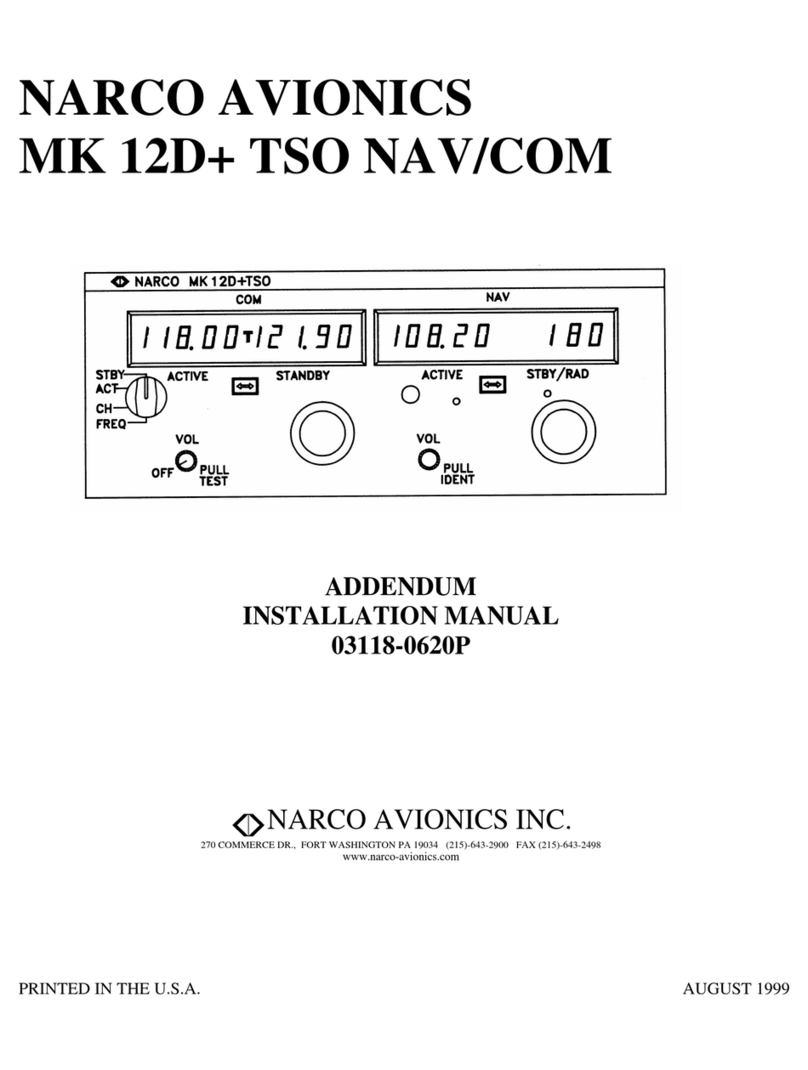
Narco Avionics
Narco Avionics MK 12D PLUS TSO NAV/COM Addendum Installation Manual
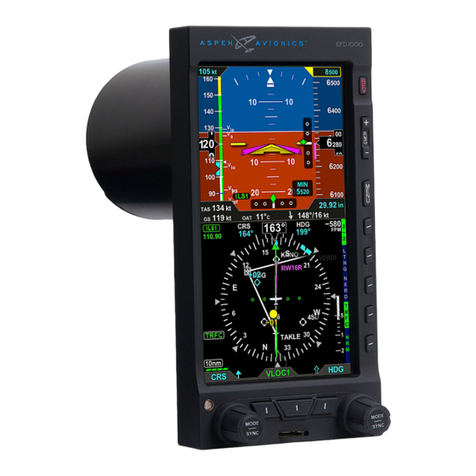
Aspen Avionics
Aspen Avionics EFD1000 Dual EFI pilot's guide
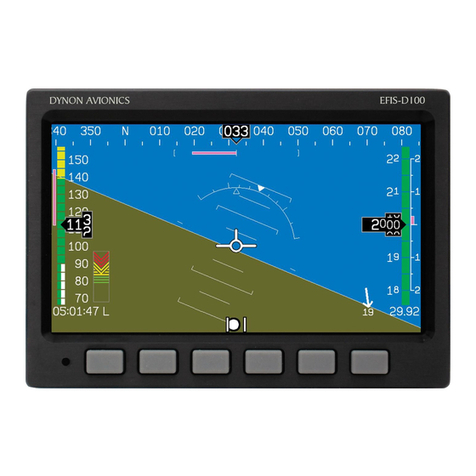
Dynon Avionics
Dynon Avionics EFIS-D100 installation guide

DYNANAV
DYNANAV DynaFlight-AirAgII manual
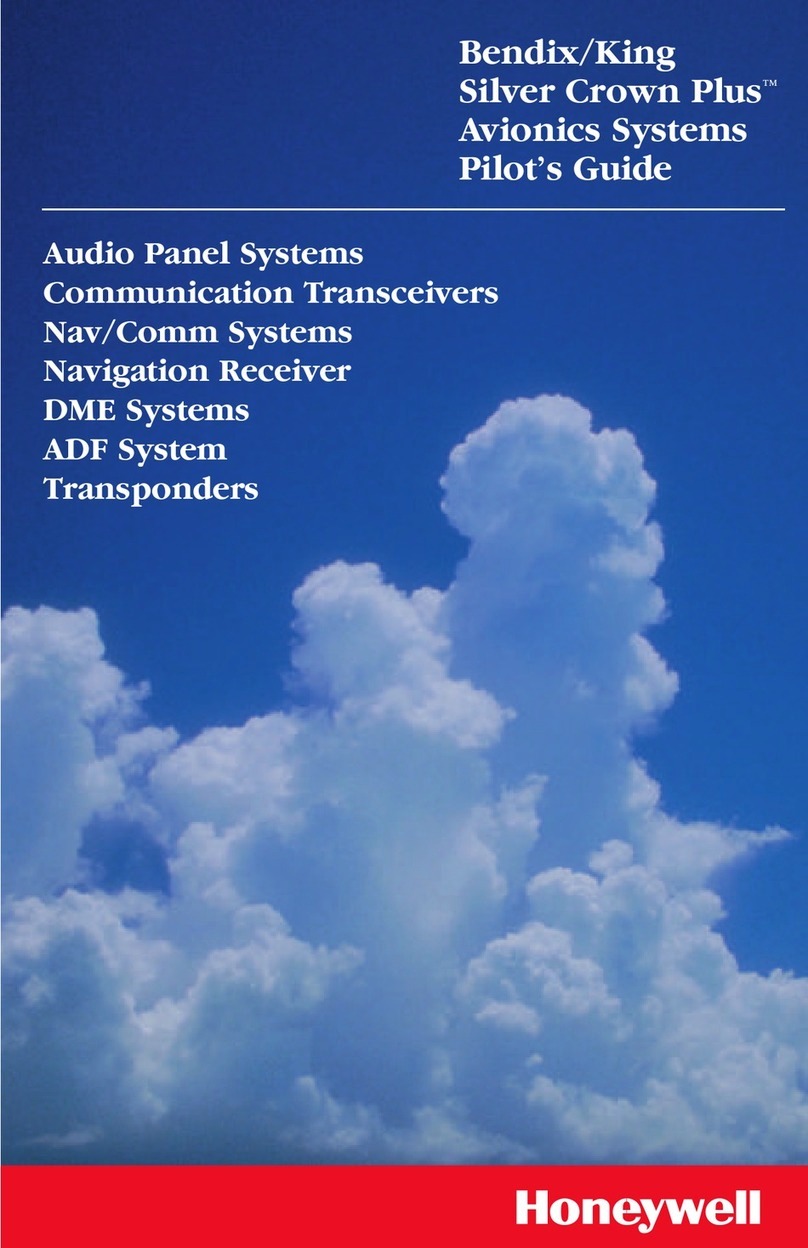
Honeywell
Honeywell Bendix/King Silver Crown Plus pilot's guide
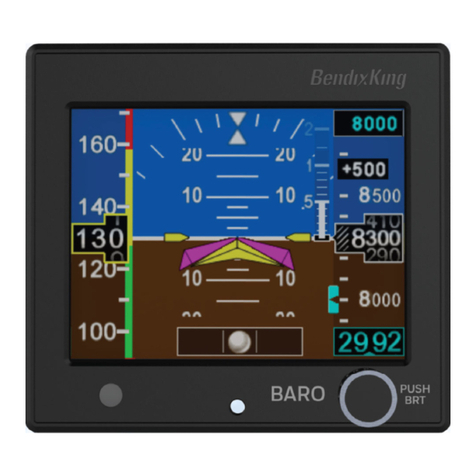
BENDIXKing
BENDIXKing KI 300 pilot's guide

